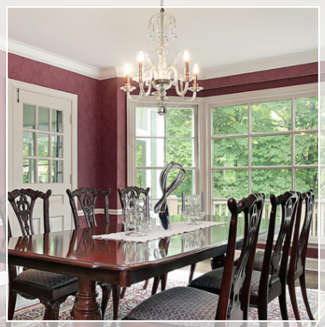Lighting Your Dining Room
Create a Focal Point
 Your dining room is likely furnished with a table, chairs and possibly a China cabinet or bar. This space has much less furniture than the other rooms in your home, so the main lighting source should be eye-catching. Keep in mind that for the best distribution of light, the bottom of a fixture should be about 36 inches above the table. How do you decide if that fixture should be a chandelier or a pendant?
Your dining room is likely furnished with a table, chairs and possibly a China cabinet or bar. This space has much less furniture than the other rooms in your home, so the main lighting source should be eye-catching. Keep in mind that for the best distribution of light, the bottom of a fixture should be about 36 inches above the table. How do you decide if that fixture should be a chandelier or a pendant?
When to Choose a Chandelier
As a general rule of thumb, select a chandelier if your dining room table is round. The spherical shapes will complement each other and any traditional décor in the room.
When to Choose a Pendant
Linear suspension fixtures are a more modern take on dining room lighting. With a linear pendant, light will be spread across to each end of your dining room table.
Focus on Task Lighting
The main event in your dining room is dinner. So, your family and guests should be able to see their food as well as each other! Task lighting should be the central focus when designing the lighting layout of your dining room. Is there enough light over the table?
Accent with Wall Sconces
Only one source of light can create a glare or cast shadows. After task lighting, you can focus on accent lighting. If you have artwork hanging, wall sconces are the perfect fixtures to draw attention to those pieces while providing a little extra illumination.
Set the Mood
Finally, consider a dimmer switch for the dining room. This will allow you to control the ambiance on command. If you have friends over for dinner, the light can be on full bright during the meal, but after dinner drinks will feel more relaxed under softer lighting.
Shop the largest lighting inventory in New England at Connecticut Lighting Centers. Visit our Hartford or Southington showroom today to find the perfect fixtures for your dining room.
